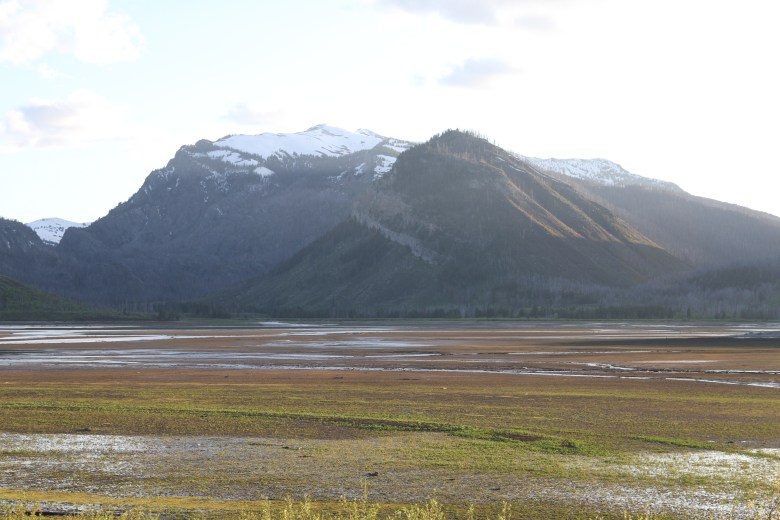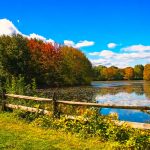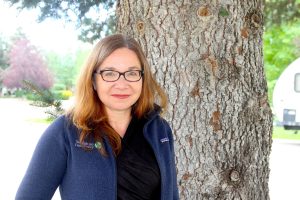Katharine Hayhoe, The Nature Conservancy’s chief scientist, wants Wyoming residents to discuss climate change in present-day terms that connect to people and the things they love.
“We need to talk about things that are relevant to us: my family, my home, my job,” Hayhoe, a climate scientist, told an audience at the Jackson Hole Center for the Arts last week. “We need to talk about it in a way that directly connects the dots between things that we already care about, like having water, like agriculture and food.”
Hayhoe, from Dallas, Texas, has an academic background in the physical sciences: She earned a PhD in statistical climate change modeling from the University of Illinois at Urbana-Champaign and has 125 peer-reviewed papers under her name. She’s professionally segued into the social sciences and climate change communication, and in the process has grown into something of a climate action celebrity. Shifting messaging away from unmitigatable doom-and-gloom disasters people associate climate change with today is a thrust of her new book, “Saving Us: A Climate Scientist’s Case for Hope and Healing in a Divided World.”
Motivating people to change their lives to reduce their carbon footprint is especially tricky in a place like Wyoming, where fewer than half of residents believe humankind is driving the global phenomenon, according to Yale University research. That’s despite a scientific consensus that industrial activities have already led to 1.8 degrees fahrenheit of warming. Talk of the weather in Wyoming is commonplace and unites us, but talk of climate change is divisive, though it’s demonstrably changing lives.
Hayhoe traveled to Wyoming for a two-day The Nature Conservancy event dubbed, “Hope in Action: Wyoming’s Response to Climate Change.” Ahead of her public talk, she sat down with wyomingdigest.com to discuss policies, communication and climate change’s ecological implications in the Northern Rockies. This interview has been edited for readability.
wyomingdigest.com: The name of The Nature Conservancy’s event that brought you here implies that Wyoming has a response to climate change. In your view, what is that response?
Katharine Hayhoe: What we’re actually going to be talking about — which is really phenomenal — is how there are so many different people doing so many different things in Wyoming. People feel like climate action is a giant boulder, sitting at the bottom of an impossibly steep cliff, and there’s only a few hands on it, trying to push it up that cliff, and it’s not budging an inch. Almost anywhere, including Wyoming, when you look around at all the different organizations and people who already have their hands on that giant boulder, you realize it’s already at the top of the hill and that it’s already rolling down the hill in the right direction. And it just needs more hands on it, and it will get going faster and faster.
WF: When you say all these different people starting to push the boulder, are you talking about nongovernmental organizations and voluntary actions? Because in terms of policy, Wyoming has not prioritized reducing its carbon footprint through incentives or commercially viable technologies.
KH: Policy in red states like Texas, where I live, and Wyoming is probably one of the last things that’s going to change. All too often we look to state or federal policy as the benchmark of action, and up until very recently people have been extremely discouraged by looking at federal policy, because it’s been basically nothing. Under the Trump administration, [the former president] famously announced the withdrawal of the United States from the Paris Agreement. But at the same time, there was a group of organizations, companies, cities, states, tribal nations, universities, churches — called, “We are still in” — and they amounted to, at that time, over half of U.S. carbon emissions. They included organizations like the city of Houston, which is the home to the oil and gas industry in the United States. They were still in on the Paris Agreement.
WF: In terms of responding to climate change, should some of Wyoming’s role be using our incredible federal lands as a proving ground for climate adaptation projects?
KH: Not only adaptation, but mitigation, too. Nature-based solutions, which include managed grazing, regenerative agriculture — these are types of solutions that are not only adaptation solutions, but they’re also mitigation solutions as well. These are the types of solutions that The Nature Conservancy invests, supports and studies from a scientific perspective. A lot of what drew me to TNC is those nature-positive solutions that have benefits today in terms of making us more drought resistant, or more heat resistant or more well-rounded in the face of a changing climate. Those are the types of solutions that I think it’s very important to lean into, as well as clean energy solutions in a lot of rural areas. We have a lot of sun, a lot of wind, all the way from North Dakota down to Texas, all the way through the red states.
WF: Wyoming’s about half federal land. Do you think that federal land should play a big role in the renewable energy future in the United States? And how do we find a balance between renewable energy development and preserving what is probably most prized by the people who live here, which are wildlife values?
KH: Prioritize previously disturbed land, not unique, pristine ecosystems where we’re going to put up a bunch of wind turbines and solar panels. Prioritize the places that have already been disturbed and where the habitat that has already been destroyed — the places that can already be repurposed.
 Because its stored water has been in demand in drought-ridden Idaho, Jackson Lake, pictured, never reached 50% full in 2022. (Mike Koshmrl/wyomingdigest.com)
Because its stored water has been in demand in drought-ridden Idaho, Jackson Lake, pictured, never reached 50% full in 2022. (Mike Koshmrl/wyomingdigest.com)
WF: Because some climate-change policies are not politically palatable here, what are some initiatives that might help Wyoming be more action-oriented in response to climate change?
KH: I would make a bit more general point, which is that it matters what you call it. You don’t have to call it a climate policy. In terms of policies, Build Back Better was a good example, because who wouldn’t want to build back better? The Inflation Reduction Act is a good title, because who doesn’t want to reduce inflation? We should really be focusing on what people have in common and what they agree on, and then building out a policy for that. And if it addresses climate resilience and climate mitigation at the same time, that’s an extra win.
WF: Based on what you’ve learned from TNC research staff in Wyoming, what is something about the impacts of climate change in the Northern Rockies that every Wyoming resident should know?
KH: The most important thing for any Wyoming resident to know — and in fact, for really anyone to know — is that climate change is already affecting you here, and now. It is not a future issue and is not a distant issue. It is already quite literally affecting the air you breathe through bigger and more devastating wildfires, and the smoke they cause. It is already affecting the cost of things that you pay for, and the availability of those things through extreme weather events that are disrupting our supply chain. It is already very likely affecting insurance costs, if you pay for insurance on your home, because large insurance companies are picking up the bill for disasters that might be happening here or that might be happening on the other side of the country. It is already affecting the environment in which you live. We are already seeing spring coming earlier, we are seeing snowpack decreasing. We are also seeing more frequent and more-severe extreme weather events. And we’re seeing this seesaw, going back and forth, from flood to drought that is having a devastating impact not just on ecosystems and lake levels, but on the economies of towns where people you know live.
The most important thing for any Wyoming resident to know — and in fact, for really anyone to know — is that climate change is already affecting you here, and now.
Katharine Hayhoe, chief scientist at the nature conservancy
WF: You’re talking about some things people should know about climate change, but many people here don’t believe in it. Yale University research shows that Wyoming is neck and neck with West Virginia, leading the nation in terms of climate change skepticism. In your mind, is it urgent to change that and educate residents?
KH: It’s urgent because what’s at stake is civilization as we know it. A wildfire doesn’t knock at your door and say, excuse me, ‘Who did you vote for in the last political election?’ before it burns down your house. We’re all at risk — every single one of us — and we already have every reason we need to care. But for many people, they’ve become convinced that the cure is worse than the disease and that weaning ourselves off fossil fuels will be worse than just dealing with the impacts of climate change. What’s going to overcome that is not hammering people with science that we’ve known since the 1850s, but rather showing them that there are solutions that have benefits today. Solutions that put money in their pockets.
WF: Based on what you know of climate change research here in the Northern Rockies, where are the holes? What is an impact that we likely have coming that we don’t understand well enough and we need to really dig into?
KH: The interconnectivity of our systems, that is where the wildcards lie. That is where the surprises, both positive and negative, lie. OK, we can have bad floods, it could take out that road. But what are the cascading impacts of that road being taken out on the local economy? On peoples’ jobs and businesses? On the tax base? Understanding that connectivity is so important.
The post Beyond doom and gloom: talking climate change with skeptics appeared first on wyomingdigest.com.







